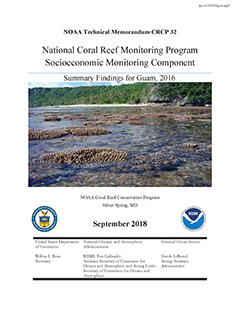-
Home
-
Data & Publications
-
Regional Portals
- About Regional Portals
- Florida
- Navassa Island
- Puerto Rico
- Flower Garden Banks
- U.S. Virgin Islands
- American Samoa
- Commonwealth of the Northern Mariana Islands
- Federated States of Micronesia
- Guam
- Main Hawaiian Islands
- Republic of the Marshall Islands
- Northwestern Hawaiian Islands
- Republic of Palau
- Pacific Remote Island Areas
-
CRCP Activities
- Glossary
National Coral Reef Monitoring Program Socioeconomic Monitoring Component: Summary Findings for Guam, 2016

The Socioeconomic Component of the National Coral Reef Monitoring Program (NCRMP) is currently in the process of monitoring socioeconomic indicators across all U.S. coral reef territories and jurisdictions. These indicators fall under the following broader categories: the demographics of these areas, human use of coral reef resources, and knowledge, attitudes, and perceptions of coral reefs and coral reef management. The overall goal of this endeavor is to track relevant information regarding each jurisdiction's population, social and economic structure, society's interactions with coral reef resources, and the responses of local communities to coral management. NOAA's Coral Reef Conservation Program (CRCP) will use the information for future research, to assess the socioeconomic outcomes of management activities, and to improve the results of programs designed to protect coral reef resources.
This report outlines human dimensions information relevant to coral reef resources in Guam. The findings here are derived from a combination of data gathered through household surveys conducted from February to July of 2016, and additional secondary sources of socioeconomic information for the region. Survey results show that Guam residents participate in swimming and beach recreation most frequently. Additionally, 30% of residents indicated that they participate in fishing or gathering of marine resources. Perceptions concerning marine resource condition tend to vary amongst Guam residents, they generally support a range of potential marine management policies and regulations, and are moderately familiar with the various threats facing coral reefs.
There were key lessons learned from this first NCRMP socioeconomic data collection in Guam. This was the first iteration of the NCRMP socioeconomic survey that distinguished between pelagic fish/seafood consumption and reef fish/seafood consumption. The findings contained within this report represent the baseline assessment for future socioeconomic monitoring of Guam's coral reefs, and they will feed into composite indicators that will detail the status of Guam's coral reef adjacent communities in relation to the other US coral reef jurisdictions. Surveys are planned to be repeated in each US coral reef jurisdiction after the completion of a full monitoring cycle, approximately once every five to seven years.
Citation: M. Gorstein, J. Loerzel, A. Levine, P. Edwards and M. Dillard. 2018. National Coral Reef Monitoring Program Socioeconomic Monitoring Component: Summary Findings for Guam, 2016. US Dep. Commerce, NOAA Tech. Memo., NOAA-TM-NOS-CRCP-32, 64p. + Appendices. doi:10.25923/kpvd-mj07
National Coral Reef Monitoring Program Socioeconomic Monitoring Component: Summary Findings for Guam, 2016: (full report, 4.65 MB)


